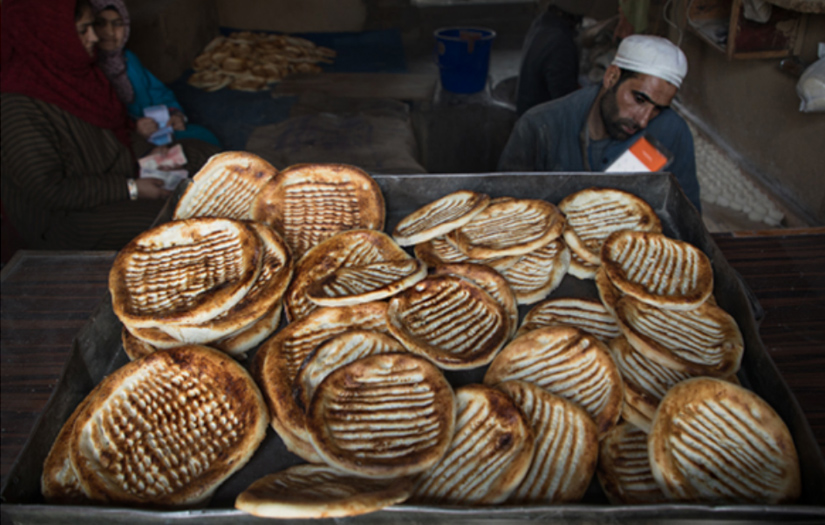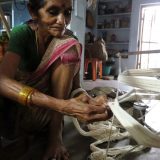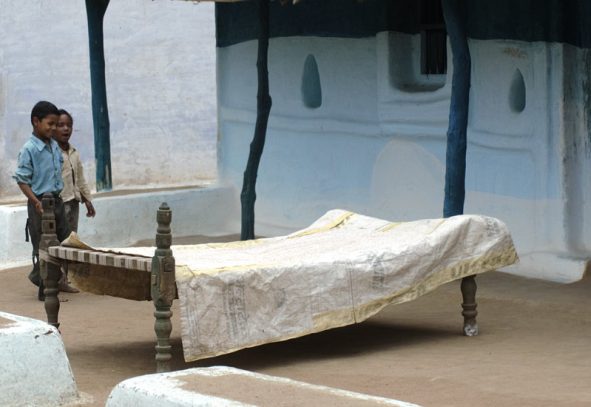Kandur waan…

It’s raining outside. The off-white walls of the old mansion turn from a spotted leopard to a darker shade of grey, looking beastly. Though, with a yet darker mane of Deodar wood perfectly parted in the center, the beast looks tamed and well groomed. The sky seems hell bound, it is going to paint the whole valley gray today. Gloom & doom on the outside, the kindled pot of fresh amber is keeping hookah puffing Amma warm inside.

Its five’o clock in the morning and she is wide awake, ejecting ring after ring of gray smoke… gazing into eternity… She seems on a serious business of setup a connection with the huger, grayer clouds outside… as her rings ascend and merge with the sky, a line of thoughts seems to charge her through an invisible cable. Meanwhile, it is a good spectacle, strictly to be left undisturbed. Grasping the situation Dadu, who is equally awake at this early hour, grabs his kindled fire pot within the tent of his Ferhran & sets off to venture into the wet lanes of the neighborhood. The day doesn’t seem to be getting any brighter than the early hours of morning. A mild drizzle will keep pouring off & on. Fast on his foot, Dadu reaches Kandur-waan, the neighborhood bread maker’s shop. Kandur, the baker apart from Amma & Dadu is the only one in the city who wakes up way before sun does & is soon sending smoke signals to sky. He greets:-
“Salam valle kum, All well?”
“Namaskar, Yes! Yes! Paantch gyev cwtche te shey kulche vairé.”
“Ahan mahra. Bus akh minute, Naar hyatun tayaan gatchun.”
(Yes sir, just a minute, the fire is beginning to prepare)
Real online poker has meant that not as many people are playing live games, but the internet has allowed many of the major players to become famous and easily recognized. They spend their time between online poker games, as well as real life tournaments and cash games.

He offers a burning stick to smoke holding Dadu, who has by now naturally huddled up closer to the warm entrance of the shop. Sitting comfortably on the wooden frame, that seems to have been designed for people to get comfortable and not feel the pinch of long passing time Kandur may take to prepare the order. He has ample time for keen observations; a knee high platform with wood frame on mud flooring is just the right thing to sit on in this freezing winter, especially when warmed by a nearby oven…

The bakery opens up to the street as an extension to the house and has just a door & a wider window for all transactions & communications to happen… It also of-course serves the house behind. The space within is divided into two levels with a raised platform which holds underneath a large earthen pot with its mouth opening on top… Baked in these wood fire Tandoors, the dough rises into a crispy soft bread, while smoke gives it a unique flavor…

The space is lit with diffused light emitting from bulbs coated with soot… Over the years soot has painted the upper part of walls and the ceiling black… rather enhancing the landscape of activities beneath… A classic from era bygone is the image in front of him… a smoke filled monochromatic memory of dough being slapped onto a hot wall of clay in rhythm, moving in and out of the glowing oven with bare hands…

The morning battalion joins soon after… There is an exception today though…
“Is he a tourist or a native visiting after long?” Queer inquisitiveness takes over the group and the drill starts…
With his tanned skin, sore shoulders and blisters on his feet… he could have passed very much for a begging fakir but his gear was not casual, nor was it tattered…
“Are you returning from a trek to the mountains?”
“We’re all roving travelers, tripping down our discrete roads… hopping, wishing, someone will come to join our voyage… we brave the wildest traffic and the scorching summer heat… Sometimes we find someone who is going our way… while they walk beside us, the sky seems little bluer and distances shorter… But all roads twist and turn and reach a crossroad… ” came the reply.
“When there is No way, there is a Nan wai… Kashmir ke Kandur aur uske Kandur waan…”, comments someone pointing towards the baker’s shop.
Intersections let us converge… we stop for rest, get our muscles relaxed, indulge in local gastronomy, make new friends, gather new stories and grow stronger to tug along the hidden path, discovering small wonders of everyday life… Walking through these small hill towns, protected valleys, on rickety wooden walkways on the Dal and dense down-towns of Kashmir, one gets pulled to these un-obsequious corners, that whiff of sweet smell and smoke puffing out… these Kandur-waans, the converging points of every neighborhood…

Since hundreds of years these artisan bakers have nourished their communities with the work of their hands, kneading and letting their dough rise, stoking the fire in their ovens and baking traditional loaves, day in and day out. These accomplished practitioners are dotted all over the valley…Well before every one wakes up from their sleep a kandur opens his doors, fires the Tandoor… Throughout the day he is busy and in-between catches up a nap and then stokes the fire again… for many a variety of breads to be made, to be consumed during different hours of the day and at different occasions… Czot, Girda, Lawaas, Czochwor, Kulcha, Czochwor kulchè, Khatai, Katlam, Bagirkhein, Ghyev czhot, Shrumal or Krippe… are the many varieties that come out of these intriguing burning ovens…

Making bread in Kashmir has evolved from a strong Central Asian influence and thus has become a part of the culture in its own unique way to Kashmiris… for a society whose staple food is rice, this amazing range of traditional breads is savored for breakfast and as afternoon snack every day and also during festivals & weddings… separately by itself or alongside a hot Nun-chai or Kehwa or with barbecued meat and Masala chickpeas…

“Bread is merely flour, salt water and yeast… as this world is merely earth, water and play of fire with air… Grain from the fields, water from mountain streams, salt from sea and leavening from the wild yeast in nature have come together since time immemorial to make loaves and loaves of bread…”

The sky began to clear-off as one of them pointed to time. Paying dues to each other and the Kandur, some made a hasty exit from the warming up discussion. Some split into smaller groups of two or three to talk in private… while a few engaged themselves with the new man, teaching him ways a Czot can be best had with a hot cup of Nun-chai. Warm, pink tea had left salt on their lips & their insides warmer. Everyone eventually left with their baskets full of warm golden breads, varied many in form and taste and so did the new traveler with his strange attire and even stranger way of talking…

“Taste is often a matter of texture… and texture of many things…” he said as he left. Some fading murmurs could still be heard as he kept walking farther and farther…

When it comes to breads, a well composed dough gone under the weight of Kandur’s deft hands, measuring salt & water like a chemist but without test tubes & pipits, forms the body of the bread. The soul of it is a matter of fire & air play…. settling as a proof of existence; layers of black soot on everything earth around it.
As a Tandoor is fed with fresh fire every day, the souls feeding on it rise with warmth every morning…
♠

The Breads
Czot or Girda or Roti
It is a six inch round everyday breakfast bread. A small ball of dough is spread across a stone platform with the palm dipped in milk. Texturing it with the impression of the fingers, the naan-wai pulls the stretchy dough off the stone and slaps it on the warm oven wall gently. It come out with golden on the upper side and white on the lower and is usually had with butter or jam along with nun-chai.
Ghyev czot
With addition of ghee to the dough, a Czot becomes Ghyev czot. A softer variety of bread, it is relished during special occasions and festivals.
Lawaasé
It is a thin, large, unevenly puffed roti, made from unleavened dough. This somewhat flat bread, white in color is made of Maida. Some Lawaaséare soft while others come out crispy. Soft ones are had as wraps with barbecued meat or chickpeas inside and are known as Masala Lawaasé
Czochwor
Shaped like a donut Czochwor is a small, soft, round bread of about three inches diameter. Soft on the inside with a crispy upper crust, usually sprinkled with sesame or poppy seeds. It is made after lunch and savored with a hot cup of nun chai in the afternoon or early evening. Hot Czochwor are best in taste and locals dunk it in a cup of nun tea and eat.
Kulcha
Kulcha is small, hard, dry, crumbly bread, usually round in shape and sprinkled with poppy seeds. The regular kulche is salty. There is a sweet one also, which is called Khatai, it is sugary and big. A hybrid with the taste of one and the form of the other is called Czochwor kulche.
Shurmaal or Krippe
It is dry crumbly bread with a long shelf life, salty as most kashmiri breads are, Shurmal, also known as Krippè is usually served with kehwa.
Bagirkhein
Baked in layers and often served with kehwa, Bagirkhein is more like puff pastry. It is made by stretching sheet of dough repeatedly, interleaving with ghee before baking in a tandoor.
Katlam
A Katlam resembles a Bakirkhani and is usually crispy and thin. It is also smaller in size, nearly of palm width.











braided bolo cord
You shared awesome post and detail about this post. Loved your information. Look delicious post and idea also. Thank you so much!
Chitra
Loved this post
Pl share any previous posts
Thank you
discounts on essays on our site
Every nation has its own national cuisine and there are always many stories that are around this topic.
Culturalsoil
Awesome Post Very nice way of telling the traditional food of Kashmir